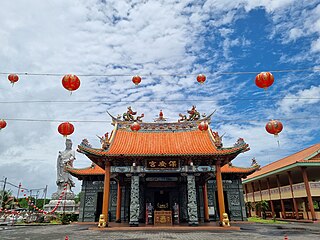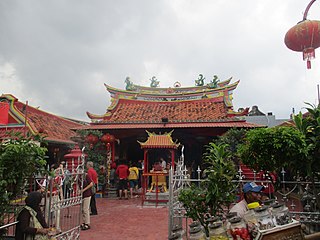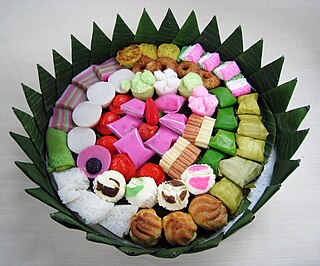
The Peranakan Chinese are an ethnic group defined by their genealogical descent from the first waves of Southern Chinese settlers to maritime Southeast Asia, known as Nanyang, namely the British Colonial ruled ports in the Malay Peninsula and the Indonesian Archipelago, as well as Singapore. Peranakan culture, especially in the dominant Peranakan centres of Malacca, Singapore, Penang, Phuket and Tangerang, is characterized by its unique hybridization of ancient Chinese culture with the local cultures of the Nusantara region, the result of a centuries-long history of transculturation and interracial marriage.

Tangerang is the city with the largest population in the province of Banten, Indonesia. Located on the western border of Jakarta, it is the sixth largest city proper in the nation. It has an area of 164.55 km2 (63.53 sq mi) and an official 2010 Census population of 1,798,601, which had risen to 1,895,486 at the 2020 Census – making it the eighth most populated suburb in the world at the latter date; the official estimate as at mid 2023 was 1,912,679 - comprising 961,354 males and 951,325 females.

Indonesia's Legislation on Chinese Indonesians were conducted through a series of constitutional laws and directives enacted by the Government of Indonesia to enforce cultural assimilation of ethnic Chinese in Indonesia with the wider Indonesian society. The legislations mostly regulated individual naming conventions and business statutes.

Kota Tua Jakarta, officially known as Kota Tua, is a neighborhood comprising the original downtown area of Jakarta, Indonesia. It is also known as Oud Batavia, Benedenstad, or Kota Lama.

Benteng people are a Chinese Indonesian community of 'Peranakan' or mixed descent, native to the historic Tangerang area in the modern-day Indonesian provinces of Jakarta, Banten and West Java.

Kwee Tek Hoay was an Indonesian Malay-language writer of novels and drama, and a journalist.

Drama dari Krakatau is a 1929 vernacular Malay novel written by Kwee Tek Hoay. Inspired by Edward Bulwer-Lytton's 1834 novel The Last Days of Pompeii and the 1883 eruption of Krakatoa, the sixteen-chapter book centres on two families in 1920s Batam that are unknowingly tied together by siblings who were separated in 1883. The brother becomes a political figure, while the sister marries a Baduy priest-king. Ultimately, these families are reunited by the wedding of their children, after which the priest sacrifices himself to calm a stirring Krakatoa.
Loa Sek Hie Sia was a colonial Indonesian politician, parliamentarian and the founding Voorzitter or chairman of the controversial, ethnic-Chinese self-defense force Pao An Tui (1946–1949). He was a Peranakan of Chinese-Indonesian, Austrian and Javanese descent. In his political career, he campaigned against racial discrimination and demanded better healthcare and education for ethnic Chinese in the Dutch East Indies.

Vihara Satya Dharma is a modern Chinese temple at Benoa Port, Bali. It is a temple of the Three teachings ("Tridharma") of Chinese folk religion, i.e. Buddhism, Taoism, and Confucianism. Furthermore, like the other Chinese temples in Bali, this temple also has an altar in its outdoor yard dedicated to Gods of Balinese Hinduism.

Hoo Ann Kiong Temple is the oldest Chinese Taoism temple in Selat Panjang. This temple is the oldest in Riau province and on Jalan Ahmad Yani, Selat Panjang, Riau. It is one of the cultural heritage assets of the Meranti Islands Regency.

Kim Tek Ie Temple, also called Vihara Dharma Bhakti, also known as 金德院, is a klenteng located in the China Town neighborhood of Glodok, Jakarta, Indonesia. Completed in 1650, Vihara Dharma Bhakti is the oldest Chinese temple in Jakarta.

Tio Tek Ho, 4th Majoor der Chinezen was an ethnic Chinese bureaucrat in the Dutch East Indies who served as the fourth and penultimate Majoor der Chinezen or Chinese headman of Batavia, now Jakarta, capital of Indonesia. This was the most senior position in the Chinese officership, which constituted the Chinese arm of the civil bureaucracy in the Dutch East Indies. As Majoor, Tio was also the ex officio Chairman of the Chinese Council of Batavia, the city's highest Chinese government body.

Boen Tek Bio is the oldest Chinese temple in Tangerang, Indonesia. It is located at the corner of Jalan Bhakti and Jalan Cilame in the heart of Pasar Lama, Tangerang's old market district.

Oey Djie San, Kapitein der Chinezen was a Chinese-Indonesian public figure, bureaucrat and landlord, best known for his role as Landheer of Karawatji and Kapitein der Chinezen of Tangerang. In the latter capacity, he headed the local Chinese civil administration in Tangerang as part of the Dutch colonial system of 'indirect rule'.

Oey Giok Koen, Kapitein der Chinezen was a Chinese-Indonesian public figure, bureaucrat and Landheer, best known for his role as Kapitein der Chinezen of Tangerang and Meester Cornelis, and as one of the richest landowners in the Dutch East Indies. As Kapitein, he headed the local Chinese civil administration in Tangerang and Meester Cornelis as part of the Dutch colonial system of 'indirect rule'. In 1893, he bought the particuliere landen or private domains of Tigaraksa and Pondok Kosambi.
Oey Khe Tay, Kapitein der Chinezen was a Chinese-Indonesian bureaucrat and landlord, best known for his role as Kapitein der Chinezen of Tangerang and Landheer of Karawatji. In the former capacity, he acted as the head of the Chinese civil administration in Tangerang as part of the Dutch colonial system of ‘indirect rule’.

Jajan pasar refers to traditional Javanese cakes sold in Javanese markets.

Tio Tek Hong (1877–1965) was a colonial Indonesian businessman and record executive, best-remembered as a pioneer of the Indonesian music recordings industry and as the founder of Toko Tio Tek Hong, one of the country's earliest modern department stores. He was also the first person to make a recording, in 1929, of Indonesia's future national anthem, Indonesia Raya.
















